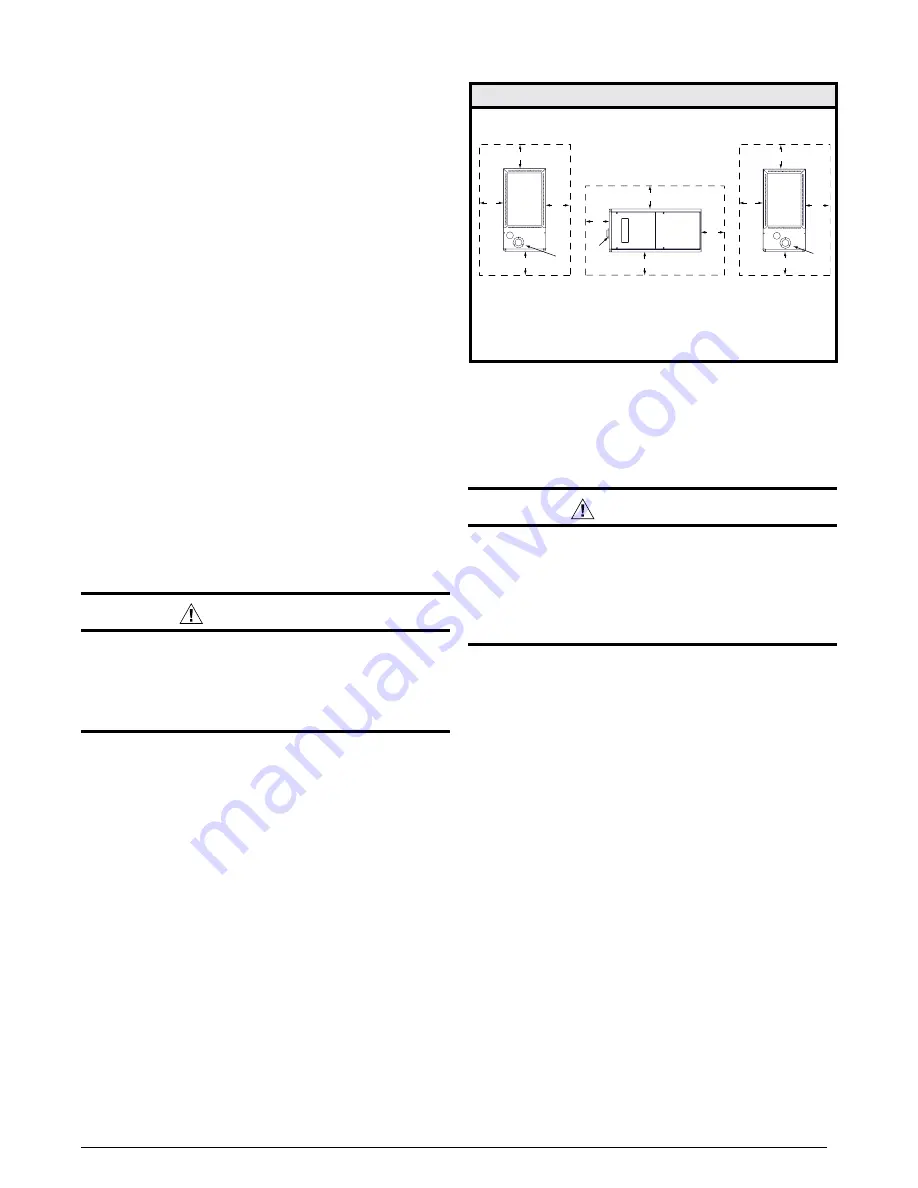
5
• Exposure to the following substances in the combustion
air supply may require outdoor air for combustion:
Permanent wave solutions
Chlorinated waxes and cleaners
Chlorine based swimming pool chemicals
Water softening chemicals
De-icing salts or chemicals
Carbon Tetrachloride
Halogen type refrigerants
Cleaning solvents (perchloroethylene)
Printing inks, paint removers, varnishes, etc.
Hydrochloric Acid
Cements and glues
Antistatic fabric softeners
Masonry acid washing materials
Heating Load
This furnace should be sized to provide the design heating
load requirement. Heating load estimates can be made
using approved methods available from Air Conditioning
Contractors of America (Manual J); American Society of
Heating, Refrigerating, and Air Conditioning Engineers; or
other approved engineering methods.
Excessive oversizing
of the furnace could cause the furnace and/or vent to
fail prematurely.
The ductwork should be appropriately sized to the capacity of
the furnace to ensure its proper airflow rating. For installations
above 2,000 ft., the furnace should have a sea level input
rating large enough that it will meet the heating load after
deration for altitude.
Installation in a Garage
WARNING:
Do not place combustible material on or against
the furnace cabinet or within 6 inches of the
vent pipe. Do not place combustible materials,
including gasoline or any other flammable vapors
and liquids, in the vicinity of the furnace.
This gas-fired furnace may be installed in a residential garage
with the provision that the burners and igniter are located no
less than 18 inches (457mm) above the floor. The furnace
must be located or protected to prevent physical damage
by vehicles.
Clearances to Combustible Materials
This furnace is Design Certified in the U.S. and Canada
by CSA International or Underwriter’s Laboratories for the
minimum clearances to combustible materials.
NOTE:
The furnace is listed for installation on combustible or non-
combustible flooring. However, wood is the only combustible
flooring allowed for installation. Downflow models must use
the appropriate subase kit when installing over a wood floor.
To obtain model number and specific clearance information,
refer to the furnace rating plate, located inside of the furnace
cabinet.
Access for positioning and servicing the unit must be
considered when locating unit. The need to provide clearance
for access to panels or doors may require clearance distances
over and above the requirements.
Allow 24 inches minimum
clearance from the front of the unit. However 36 inches
is strongly recommended.
See
for minimum
clearance requirements.
Operation of Furnace During Construction
CAUTION:
Failure to follow these instructions will void the
factory warranty and may significantly reduce
the life or the performance of the furnace, and/
or result in other unsafe conditions. It is the
responsibility of the installing contractor to insure
these provisions are met.
Operating gas furnaces in construction environments can
cause a variety of problems with the furnace. Proper use
of commercial portable space heating equipment during
construction is recommended. This gas furnace may be
used during construction if it is not in violation of any
applicable codes and the following criteria are met:
• The installation must meet all applicable codes. The furnace
must be permanently installed according to the instructions
supplied with the furnace. This includes the electrical supply,
gas piping, duct work, and venting. The furnace must be
controlled by a room thermostat properly installed according
to the instructions supplied with the furnace and thermostat.
The installation must include a properly installed air filter in
the return air duct, sealed to the furnace with no by-pass air.
The filter must be inspected frequently and replaced when
necessary.
• The furnace input rate and air temperature rise must be
checked and verified to be within the acceptable ranges as
marked on the furnace nameplate.
• Before occupying the structure: The air filter must be replaced
or cleaned, the duct work must be inspected and cleaned of
any construction debris, and the furnace must be cleaned and/
or repaired if found to be dirty, damaged, or malfunctioning in
any way by a qualified HVAC technician. The furnace shall
be inspected and approved by applicable local authority even
if this requires redundant inspections.
• Serial numbers for furnaces used during construction must
be submitted in writing (fax and email also acceptable). This
information will be used to track the long-term affects of the
use during construction on furnaces. Proof of this submittal
CLEARANCES TO COMBUSTIBLE MATERIALS
Left Side..................0 Inches Top ..........................0 Inches
Right Side ...............0 Inches Front ......................
†
4 Inches
Vent .........................0 Inches Back ........................0 Inches
†Allow 24 in. minimum clearance for servicing. Recommended clearance
is 36 in.
Figure 1. Minimum Clearances to
Combustible Materials
TOP
FRONT
UPFLOW
APPLICATIONS
HORIZONTAL
APPLICATIONS
VENT
TOP
FRONT
DOWNFLOW
APPLICATIONS
SIDE
TO
P
BO
TT
OM
VENT
VENT
FRONT
BACK
BACK
SIDE
LEFT SIDE
LEFT SIDE
RIGHT SIDE
RIGHT SIDE






































